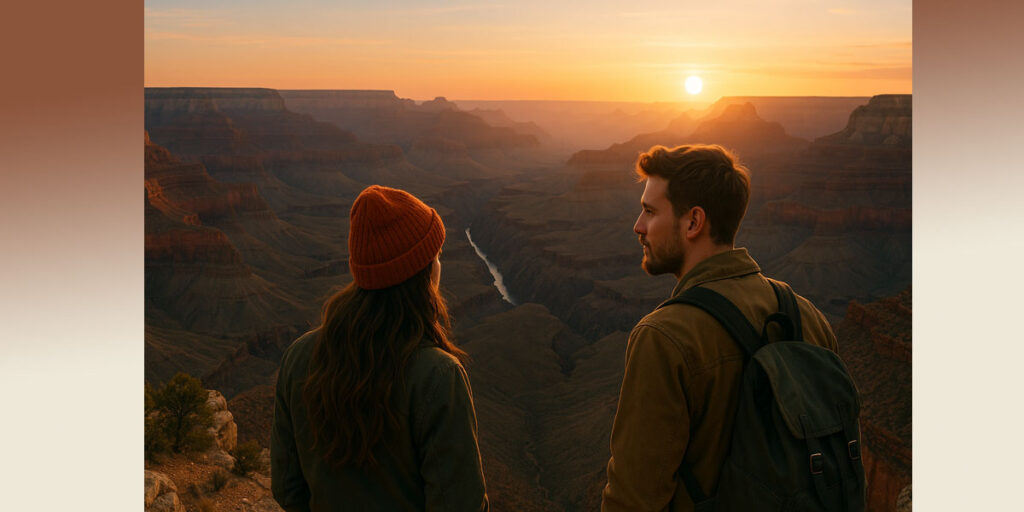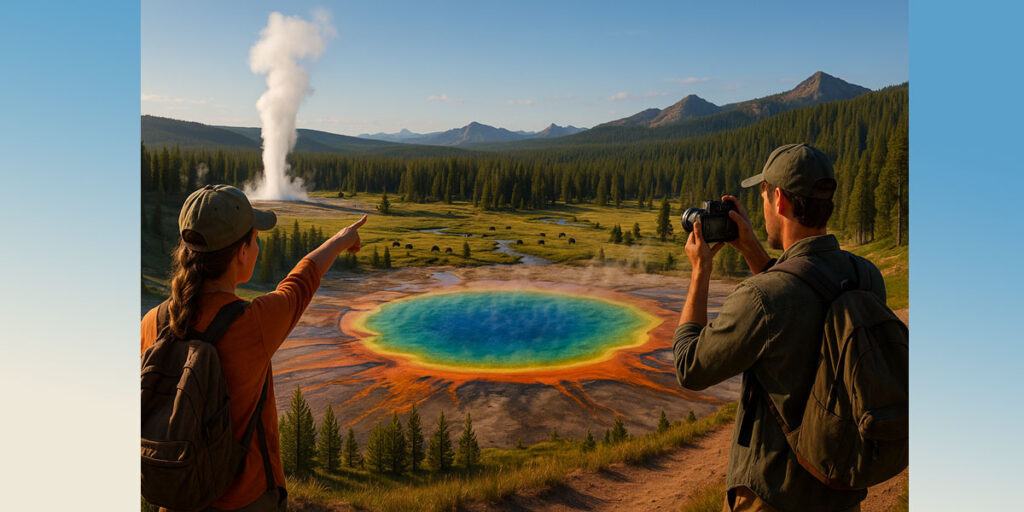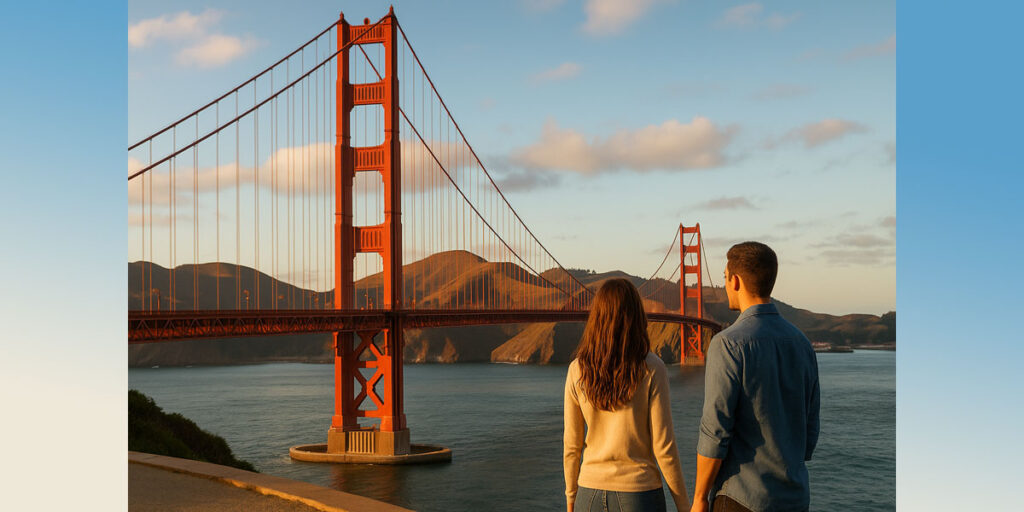Why is the Grand Canyon called one of nature’s greatest masterpieces?
They say time is the ultimate artist, and in the case of the Grand Canyon, that’s not just a poetic thought—it’s the truth carved in stone. Over 5 million years, the Colorado River has been slicing through layers of ancient rock like a sculptor with a patient hand. Imagine standing at the rim during sunrise—the cliffs glow in hues of crimson, amber, and violet. Each layer tells a story, from billion-year-old Vishnu schist to the fossil-rich Kaibab limestone. Scientists, hikers, and dreamers alike come here, not just to see rocks, but to feel the pulse of geologic time, whispered by wind and echoed by eagles soaring overhead.
Has anyone ever gotten lost in the Grand Canyon?
Absolutely—and some stories are chilling while others are strangely magical. One such tale is of a hiker named Emily in the 1990s. She ventured into a lesser-known trail alone, determined to find a hidden waterfall she had read about. The canyon has a way of playing tricks on your sense of direction—towering cliffs look familiar, shadows shift, and footsteps are swallowed by silence. After two days without seeing another soul, she finally stumbled upon a ranger patrol—dirty, exhausted, but alive. What kept her going? She swore she heard the echo of her father’s voice—who had passed away years earlier—whispering which turns to take. Whether it was a hallucination or something more, she never questioned it again.
What surprises first-time visitors the most about the Grand Canyon?
It’s the silence. Not the absence of noise, but a deep, ancient hush that seems to press against your ears. Most people expect grandeur—and they get it—but they don’t expect the emotional stillness that falls over them. A family from New York once visited with two noisy kids, both glued to their phones. As they stepped out onto the Skywalk, suspended over the canyon’s yawning depth, both children fell completely silent. For once, it wasn’t fear, boredom, or internet loss. It was awe. The kind that roots you to the earth and lifts your spirit in the same breath. When they left, the father whispered, “We came for a photo… but we’re leaving with a memory that’ll outlive all of us.”
How did the Grand Canyon become sacred to Native American tribes?
Long before it became a tourist marvel, the Grand Canyon was a spiritual home. The Hopi believe it’s the place where their people emerged into this world. For the Havasupai, it’s not just a canyon—it’s their backyard, their guardian, their ancestor. One elder once shared a story of the canyon’s voice—how at dusk, if you sit very still near the water in Havasu Creek, you can hear it hum, like the breath of the Earth. These tribes didn’t just survive in the canyon; they were shaped by it. They say its rocks remember everything, and its winds carry the voices of those who walked its paths centuries ago.
Can the Grand Canyon change how people see life?
It happened to Marcus, a Wall Street banker. Burned out and weary, he booked a random trip to Arizona. At first, he treated the canyon like a checklist—photos, sunrise, mule ride. But one evening, he hiked out alone to Yaki Point. As the sun dipped low and painted the cliffs gold, something cracked open in him. He suddenly wept—no sadness, just release. He said later, “I realized how small I was, and it didn’t make me feel insignificant. It made me feel free.” He quit his job six months later and opened a nonprofit for outdoor education. The Grand Canyon doesn’t just reshape land—it reshapes souls.
Is there more to the Grand Canyon than meets the eye?
Absolutely—and not just in depth. Beneath the obvious spectacle lies a world teeming with mystery. There are caves still unexplored, fossils older than the dinosaurs, and rare wildlife that appears like ghosts—silent bighorn sheep perched on impossible cliffs, or condors gliding on thermals like living myths. One researcher once found a tiny footprint fossil along a ledge, perfectly preserved in sandstone—perhaps from a reptile that walked there when this region was a vast sea. The canyon hides layers not just of rock, but of forgotten eras. It’s like holding Earth’s diary in your hands, if only you know how to read the lines.
What’s the best time to visit the Grand Canyon, and why does it matter?
There’s something magical about timing your visit just right. Spring, especially April and May, brings a breath of fresh life—cool breezes, blooming wildflowers along the rim, and fewer crowds. One traveler, Maya, visited in mid-April and recalled watching a dusting of snow melt into the crevices as warm sun touched the red rocks. She said it felt like witnessing the canyon awaken from a dream. Fall, around late September to October, offers fiery golden leaves and sunsets so rich they look painted. Summer may be the most popular, but the heat in the Inner Canyon can be brutal. Locals say the canyon speaks differently in each season—you just have to choose the voice you want to hear.
Is it worth visiting the Grand Canyon at sunrise or sunset?
Oh, more than worth it—it’s unforgettable. At sunrise, the canyon stirs slowly, like a beast shaking off dreams. A man named Diego once described it as “watching color being born.” He had camped near Desert View Point and woke before dawn, thinking it might not be worth it. But as the light spilled over the rim and ignited the rocks into shades of fire and wine, he stood still for over an hour. Sunset, on the other hand, is the canyon’s lullaby. The colors deepen, shadows stretch long, and silence settles. Yavapai Point is a favorite for this hour. Some say the canyon closes its eyes with the sun, and you get to witness its final thoughts.
Are there places in the Grand Canyon that only a few visitors see?
Absolutely—and they’re often the most life-changing. While millions flock to the South Rim’s lookout points, fewer venture down into the heart. Havasu Falls, for instance, lies deep within a tribal reservation and requires a hike of over 10 miles. But those who make it are rewarded with turquoise water cascading over blood-orange cliffs. Lisa and her brother made that journey one October, during the cooler season. They said the falls weren’t just beautiful—they felt like a hidden secret whispered by the Earth. Places like Tuweep, accessible only by rough roads, offer panoramic views without a single soul in sight. In the Grand Canyon, the deeper you go—both physically and emotionally—the more it gives back.
Is it possible to hear silence at the Grand Canyon?
Ask anyone who’s stood alone on the North Rim in early morning, and they’ll likely nod with a quiet smile. One traveler named Rajiv recalled hiking to Cape Royal just after sunrise in late October. No wind, no birds, no footsteps—only a thick, golden silence that felt alive. He described it not as emptiness, but presence. The kind of stillness that seems to listen back. In a world filled with constant noise, the Grand Canyon offers the rare luxury of pure, untouched quiet. Scientists have even measured it as one of the quietest places on Earth. It’s not just something you hear—it’s something you feel in your bones.
What does it feel like to hike inside the canyon rather than just view it from above?
Most people see the Grand Canyon from the rim and feel overwhelmed. But once you step below that edge, it becomes something much more intimate. Sarah, a solo hiker from Oregon, took the Bright Angel Trail one cool morning in late March. At first, it was tough—dusty switchbacks, steep drops—but as she descended, the walls rose around her like cathedral spires. She heard the trickle of hidden springs, saw lizards dart between rocks, and eventually sat by the Colorado River, stunned at how different the canyon feels from the inside. “Up top, you see the vastness,” she said. “Down below, you become part of its heartbeat.”
Why do so many people return to the Grand Canyon more than once?
Because one visit is never enough. It’s not a place you check off a list—it’s a place that changes every time you see it. A couple named Emma and Jake visited for their honeymoon in June. Five years later, they came back in November with their toddler. “It looked like a completely different world,” Jake said. This time, the colors were softer, the air was crisp, and instead of rushing to viewpoints, they sat together and let their child toss pebbles near the rim. The Grand Canyon isn’t static—it shifts with the light, the seasons, and with you. It’s not just a destination; it’s a lifelong conversation with nature.
Has anyone ever fallen in love at the Grand Canyon?
More than one love story has unfolded on the edge of those ancient cliffs. Take the tale of Rachel and Ben, strangers on a photography tour during a bright April morning. While waiting for the perfect light at Hopi Point, they struck up a conversation about camera lenses and trail shoes. That evening, they sat side by side watching the sunset melt over the canyon like gold over glass. A year later, they returned—not as strangers, but as newlyweds—standing in the same spot, whispering their vows into the canyon’s eternal silence. Locals often say the canyon doesn’t just reveal the Earth’s history—it helps people write their own.
Do people ever feel spiritual or transformed after visiting the Grand Canyon?
It happens more often than you’d think. One woman, Clara, who had recently lost her father, visited the canyon in late September seeking peace. She joined a quiet ranger-led sunrise walk at Mather Point, not expecting much. But as the sun crept over the horizon and spilled its light onto the ancient stone, she felt a warmth she hadn’t felt in months. “It felt like something opened up,” she said later, “as if my grief didn’t disappear but was somehow absorbed by the canyon.” Many visitors describe the experience as grounding, even spiritual—where nature seems to listen, hold, and gently heal.
Is it true that the Grand Canyon can be deadly—and still beautiful?
Yes, and that duality is part of its haunting majesty. In July, the sun can scorch the canyon floor to over 110°F, making every step down a challenge and every step back up a battle. There are stories of hikers unprepared for the journey, misjudging water or time. One park ranger recalled helping a young man who underestimated a descent to the river. Hours later, dehydrated and weak, he was airlifted out—but not before he whispered, “It’s the most beautiful place I’ve ever almost died.” The Grand Canyon demands respect. It’s no theme park—it’s wild, raw, and breathtaking in every sense of the word.
How was the Grand Canyon formed, and what story does its history tell?
Long before any human laid eyes on it, the Grand Canyon was already writing its story in stone. It began around 5 to 6 million years ago, when the Colorado River started cutting through layers of uplifted rock, carving a path deeper and deeper. But the rocks themselves? They’re far older—some date back nearly two billion years. One geologist, standing at the rim in the 1930s, called it “a time machine made of stone.” Each layer is a chapter: ancient seas, desert dunes, and even volcanic ash trapped in time. You’re not just looking at scenery—you’re reading the autobiography of Earth, page by ancient page.
Who were the first people to live in and explore the Grand Canyon?
Long before it was mapped by explorers, it was home to Indigenous peoples. The Ancestral Puebloans built dwellings within its cliffs over 800 years ago. Their descendants, including the Hopi, Havasupai, Hualapai, and Navajo, have lived near and within the canyon for centuries. A Havasupai elder once said, “We didn’t find the canyon—it found us.” To these communities, the Grand Canyon isn’t just a landmark—it’s sacred ground, a place woven into their origin stories and daily life. Even today, tribal ceremonies are held within its walls, keeping those ancient ties alive beneath the ever-changing skies.
When did the world first hear about the Grand Canyon’s majesty?
Though Native Americans knew it intimately for generations, the wider world first learned of the Grand Canyon in 1540, when Spanish explorer García López de Cárdenas stumbled upon it while searching for the fabled Seven Cities of Gold. He stood at the South Rim, baffled by the scale, unable to find a way down. It wasn’t until John Wesley Powell’s daring expedition in 1869—navigating the Colorado River in wooden boats—that the canyon was truly explored and documented. His journey was perilous, but his words were poetic: he described it as “a region of wild grandeur.” That exploration sparked a fascination that continues to draw millions today.






